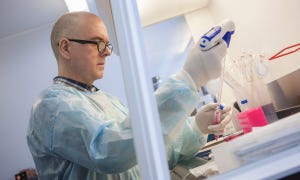PCV2 information now available in monthly SDRS reports
Based on statistical assessment, cases with an average Ct value of 22 had an 80% chance of PCV2 disease diagnosis.
June 20, 2023

The Swine Disease Reporting System aims to share information on endemic and emerging diseases affecting the swine population in the United States, assisting veterinarians and producers in making informed decisions on disease prevention, detection and management. In the response to the request from our stakeholders, the SDRS brings onboard information for porcine circovirus type 2 (PCV2) PCR positive by Ct values. Two PCV2 charts summarizing average Ct values of PCR positive submissions by the specimen (chart 1) and U.S. region (chart 2) are included in the monthly report.
Using a subset of data that provides cases with a confirmed tissue diagnosis, i.e., diagnostic codes assigned, average Ct values of confirmed tissue diagnosis were compared with the remaining submissions without a diagnostic code assigned. Based on statistical assessment, cases with an average Ct value of 22 had an 80% chance of PCV2 disease diagnosis. Therefore, when the monthly average Ct trends down toward the threshold (redline, chart 1), it represents a high risk of PCV2 cases with associated lesions.
The two charts contribute to a better understanding of the PCV2 pattern of detection in the U.S., aiding the industry to comprehend if the trend of positive cases is associated with more changes in clinical expression.
Chart 1 demonstrates the submissions broken down by specimen: processing fluid (brown), oral fluid (green), submissions without tissue samples (purple), tissue submissions (at least one tissue submitted) (yellow), and overall submissions (black). The line with non-tissue cases includes the processing fluid and oral fluid submissions.
Chart 2 demonstrates the submission's average Ct values aggregated by U.S. regions. In this chart, all the submissions with at least one tissue sample were aggregated by the U.S. regions. Regions were decided based on pig inventory and the number of submissions from each region. Figure 1 shows the defined regions in a colorful map format. The yellow line from chart 1 is broken down in chart 2 by the regions to facilitate identifying regional changes in the detection pattern.
You May Also Like



